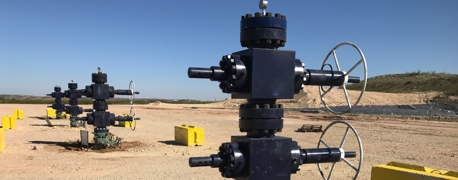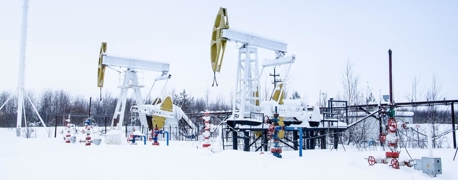What Exactly Is a "Man Camp"?

In the early 20th century, oil barons and drilling companies needed an enormous workforce to rapidly construct and operate drills and wells all over North America. Boom and bust cycles meant prices were volatile; the key for these companies was to only operate wells when extraction was profitable. Additionally, oil was typically found in remote areas, where housing and infrastructure weren't readily available. But due to the boom-and-bust nature of drilling, companies were unwilling to invest in permanent housing for what might only be a few months of drilling.
It was out of these conditions that the first "man camps" were created, although they wouldn't be called that for another century.
In 2006, the Bakken oil boom started, drawing thousands of men into remote areas of North Dakota. The boom immediately triggered a housing shortage, which led to the revival of temporary housing developments for workers. Given that these were almost entirely occupied by men, people dubbed them "man camps." These developments were so well-known that "man camp" was deemed one of the most important terms of 2012. However, as in the century prior, the boom eventually went bust, and large communities founded on volatile means dried up overnight. Still, man camps are a vital strategy for the oil-and-gas industry; it's in recent years that they have fallen under scrutiny for various controversies.
In today's article, we'll define man camps, explain some of their features, and ask whether they're worth the drawbacks and controversies they've recently been associated with.
Defining "Man Camps"
Man camps are temporary housing encampments that are typically set up near construction or resource extraction sites. They usually consist of trailers or prefabricated buildings that provide workers with basic amenities like beds and bathrooms. The North Dakota Man Camp Project, which documented the development and use of man camps, found that the term was used ambiguously to mean anything from a highly organized, manufactured dorm community to a collection of RVs parked in vacant lots. While man camps can be found all over the world, they are particularly common in North America, in part because of the unique labor developments that took place here in the late 1800s and early 1900s.
Originally, oil worker camps were permanent housing developments. Oil companies modeled them after company mining camps and textile mill camps, which were common to those industries in the late nineteenth century. However, those industries were fairly consistent, which is why they needed semi-permanent housing. The oil extraction industry was boom-and-bust, which meant permanent housing wasn't financially viable. As a result, the permanent family housing of the early 1900s was replaced by temporary camps designed for transient workers in the 1950s and 60s. These are the first man camps as we know them today.
The Different Types of Man Camps
The largest man camps are made of prebuilt dorm-style housing that can provide for hundreds to thousands of workers at once. Some companies manufacture these camps, the largest of which is Target Hospitality, while other companies create man camps ad hoc as workers create makeshift accommodations for themselves. Target Hospitality has been known to charge oil companies $100/night per worker in the biggest man camps.
Scholars divide man camps into three types:
- Type 1: Large prefabricated compounds developed by companies like Target Hospitality to house thousands of workers. Offer full housing amenities as well as paid security. Only the largest multinational corporations pay for these.
- Type 2: Organized RV parks with some administration and at least minimal government oversight.
- Type 3: Makeshift RV groups squatting on vacant lots. These were often in violation of local regulations.
What It's Like Living in a Man Camp
The most well-organized man camps operate essentially like a small town. In many cases companies have no choice but to build them; supermarkets and basic amenities are sometimes over an hour from the drillsite. Workers leave their families behind to stay in a room roughly the size of a walk-in closet, which they share with a bunkmate. In some cases, workers pay for their own bed at $36 per night. It's far preferable to motels, which charge upwards of $500 per night. Apartments aren't an option for most workers, who are paying for rent or mortgage for a family home they visit between week-long shifts.
Despite the hardships, it's fairly comfortable. There's housecleaning, air conditioning, and food. Some compounds offer amenities to stave off boredom, like rec rooms or meal plans. Other compounds have workers prepare their own meals in shared kitchens. Nearly a dozen workers might share a kitchen at one of these locations.
Man Camps No Longer?
However, amenities aren't the only thing most workers want. In many cases, workers just want to be able to live with their families in the camp. However, doing that would require a lot more than just building bigger dorms. To accommodate families, companies would need to construct modular homes that could fit parents and their children. Companies would need to build schools, hire teachers and staff to operate the schools, and construct family-friendly amenities like parks or movie theaters. It's unlikely that companies will invest long-term resources into such a volatile industry.
But there's one much larger obstacle to bringing families into the camps.
Small Towns Overwhelmed
Oil companies offer demanding, well-paid work to anyone who wants it—that's been the promise of the oilfield industry for over a century.
But any sudden influx of workers into a remote area is going to strain local resources. Small towns near man camps found themselves dealing with a population of workers who dwarfed the entire population of the town. Bars, restaurants, barbers, and countless other businesses suddenly found themselves stretched to the breaking point. Some businesses adapted; others found that they were unable to handle the sudden increase of patrons. Town administrations felt the same: infrastructure for water, power, and waste disposal was also taxed beyond capacity.
What Can Be Done About Man Camps?
At the end of the day, oil companies are the ones drawing thousands of men into remote areas and leaving them to fend for themselves in their off hours. People need to work, but oil companies need to make sure they're ensuring the safety and well-being of their workers and nearby residents in the meantime. As a law firm that represents injured oilfield workers, we know that 99.9% of workers in these industries are good, hardworking people—that's why many of them want their families around. But oil companies need to take responsibility for the impact of these man camps (and any accidents or incidents that take place within them).
If oil companies were forced to be careful about who they hired and to help workers integrate into local areas, then people could make a good living without small towns fearing for their resources. But in our experience, it's only civil suits that force oil companies to do right by the people they harm.


